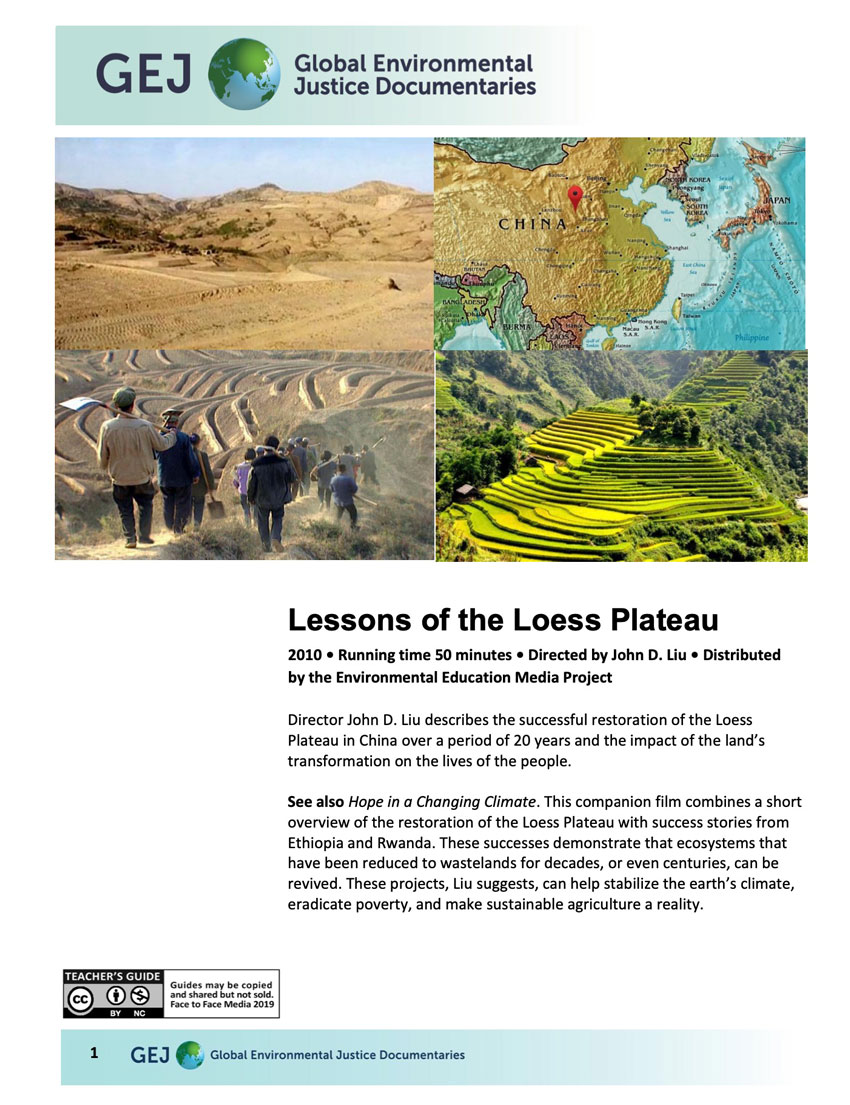Curator
 — Cinzia Fissore, Associate Professor of Environmental Science, Department of Biology and Environmental Science, Whittier College
— Cinzia Fissore, Associate Professor of Environmental Science, Department of Biology and Environmental Science, Whittier College
Lessons of the Loess Plateau
Documents a remarkable paradigm shift: the rebirth of a self-sustaining ecosystem in the dry and remote Loess Plateau region of China.

Curator
This film and its companion Hope in a Changing Climate were selected by Cinzia Fissore, Associate Professor of Biology and Environmental Science, Whittier College
Teacher's guide
Please see the teacher's guide for background info, suggested subjects, questions and activities and a discussion of the environmental justice focus of this film.
Synopsis
The Loess Plateau in north-central China is a large, hilly, semi-arid region roughly the size of Afghanistan. Thousands of years of farming, which intensified during the Cultural Revolution, left the former grasslands degraded and eroded. Food production was down, waterways filled with silt and air in faraway cities suffered from sandstorms born on the Loess Plateau. The fact that the local population had reached some 50 million people made the problems worse. Something had to be done. A massive project, funded by China's government with support from the World Bank hired local villagers to restore the ecosystem of the Loess Plateau in an area the size of Belgium, transforming the land and improving community health. Kathleen Buckingham Beyond Trees: Restoration lessons from China's Loess Plateau.
"Woefully under-publicized, the $500 million enterprise transformed an area of 35,000 square kilometers on the Loess Plateau — roughly the area of Belgium — from dusty wasteland to a verdant agricultural center. The result of careful terracing, replanting of native vegetation and restrictions on grazing, the rejuvenated land now supports a thriving local agricultural economy. Even better, the new vegetation reduces flooding and dust storms by anchoring the region’s soil and is becoming a large carbon sink. ” -- Paul Mozur, NY Times 9 Dec 2009
Woefully under-publicized, the $500 million enterprise transformed an area of 35,000 square kilometers on the Loess Plateau — roughly the area of Belgium — from dusty wasteland to a verdant agricultural center. The result of careful terracing, replanting of native vegetation and restrictions on grazing, the rejuvenated land now supports a thriving local agricultural economy. Even better, the new vegetation reduces flooding and dust storms by anchoring the region’s soil and is becoming a large carbon sink. Paul Mozur, NY Times 9 Dec 2009
Citation
Main credits
Liu, John D. (film director)
Liu, John D. (film producer)
Liu, John D. (screenwriter)
Liu, John D. (presenter)
Liu, John D. (director of photography)
Other credits
Camera: John D. Liu [and 4 others]; music: John Thompson, Shaanxi Folk Singers, Hojiagou Wedding musicians; editors: Peta Khan [and 3 others].
Distributor credits
John D. Liu
John D. Liu
Docuseek subjects
Asian Studies
History
Geography
Water
Environmental Health
Environmental Science
Sustainability
Bioregions and Habitat
Asia
Climate Change
Agriculture and Food
Agriculture Sector
Human Rights
Forestry
Farming
Food
Organic and Sustainable Agriculture
Global / International Studies
Biodiversity
Conservation and Protection
Environmentalists
Resource Planning and Management
Ecology
Family Issues
East Asia
Habitat Restoration
Environmental Geography
Distributor subjects
Asian Studies
Bioregions and Habitat
China
Conservation Biology
Cultural Anthropology
Economics
Ecosystems
Farming
Sustainability
Keywords
Welcome to Docuseek2!
Docuseek2 is a streaming platform of the best documentary and social issue films available for the higher education community.
Anyone may search for titles and find detailed information about the titles. To preview films or license them for streaming, you must register and login.
Currently, we support online registration for anyone affiliated with a higher education institution. Please inquire if you are with a K-12 district or school or with a public library.
Click the Close button to get started!



